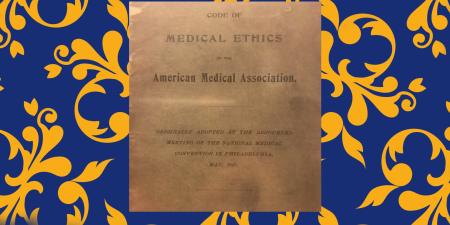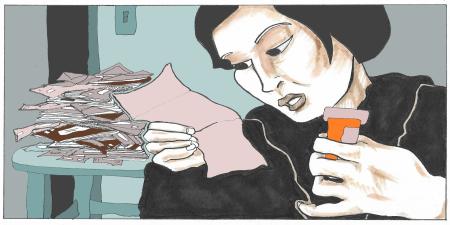Abstract
Heightened privacy and confidentiality stakes around HIV have resulted in unique anonymity and nondisclosure policies and practices. This commentary on an occupational exposure case considers benchmarks in the evolution of HIV testing. Persistent stigma continues to exacerbate ethical complexities and ambiguities clinicians face in an “end the epidemic” era.
Case
J is a general surgery resident on call for the trauma service. When responding to a call about a patient of unknown identity with multiple gunshot wounds, J sustains an accidental needlestick injury with a contaminated, large-bore, hollow needle. J follows employee health guidelines for occupational exposure to blood-borne pathogens and requests postexposure prophylaxis to minimize risk of HIV infection. The “source” patient remains unconscious in an intensive care unit and their identity is not known. Based on regulations in J’s state of licensure, the patient’s blood can be drawn and anonymously tested for HIV. J is informed that the test result is positive. In keeping with state law, the test result is not included in the patient’s health record and J is instructed not to disclose the result to the patient unless the patient consents to testing.
A week later, the patient regains consciousness. Although J doesn’t typically do so, J emphasized to the patient the importance of obtaining a routine, confidential HIV test. The patient refuses testing, stating, “I don’t have AIDS.” J believes it is a dereliction of duty not to disclose the patient’s HIV status; J reveals to the patient that, because of a needlestick accident, an anonymous HIV test was performed without consent. The patient becomes upset. J responds by clarifying that this is standard protocol for a needlestick accident, offers the patient confidential HIV testing and, if needed, treatment and counseling. J leaves the patient’s room so the patient can quietly consider their options.
About to change service assignment, J asks a fellow general surgery resident, L, to take over the patient’s care. L is aware of J’s needlestick and J’s initiating postexposure prophylaxis. J tells L, “If you develop a rapport with this patient, please counsel them to get tested. Or at least counsel them to use condoms.” J worries that, if the patient does not consent to an HIV test, other clinicians will not know that this patient has HIV and the patient will not receive necessary care.
Commentary
In the world of public health, HIV has perhaps been unique in its spread, pathogenicity, and long-standing impact. Infection is a biological event, but complex political, economic, and social dynamics often result from it. The deadly AIDS crisis of the 1980s and 1990s was characterized by a dearth of treatment options and the disease’s initial appearance in marginalized patient populations, particularly in persons who inject drugs (PWID) and men who have sex with men (MSM). Gay rights advocates feared further stigmatization and became vocal lobbyists against widespread testing.1,2 The term HIV exceptionalism arose during the early epidemic,1,2,3 and HIV exceptionalism manifested as a set of policies defining HIV as fundamentally different from other diseases. The rationale was to protect patients’ rights and maintain their privacy and anonymity, as well as to protect patients from discrimination, especially given that those most at risk (eg, MSM, PWID, sex workers) were already stigmatized and vulnerable. Civil rights groups and public health officials alike opposed HIV test reporting for this reason, as well as out of concern that patients would refuse testing or counseling if reporting were mandatory.3 As demonstrated in J’s case, although HIV is now treatable, ethical dilemmas arising from treating HIV as exceptional remain.
HIV Testing Policies
Nationwide, there is significant variability among laws and policies regarding HIV testing. These include whether and when testing is confidential and whether testing is routine for all patients unless they opt-out and actively consent to not be tested or whether testing is not done routinely for all patients, such that patients must actively opt-in and consent to testing. Such policies vary by state with respect to (1) whether testing without consent is permitted, (2) who has the authority to order HIV testing without consent, (3) how test results are officially documented, and (4) how a patient is informed. In New York State, for example, informed consent is required though it is possible to opt-out; in Washington State, laws requiring both opt-in and opt-out have been repealed.4,5,6 As of 2012, 36 states had some legal framework for occupational exposure cases, in which patients are tested for HIV without their consent (colloquially referred to in clinical settings as “unconsented” cases).7
Does a patient’s right not to know exist?
Professional societies and government agencies have also put forth recommendations regarding HIV testing. The American Medical Association states that physicians should test patients for HIV without their consent “only in limited cases in which the harms to individual autonomy are offset by significant benefits to known third parties, such as testing to protect occupationally exposed health care professionals or patients.”8 The Centers for Disease Control and Prevention (CDC) recommends only that a person whose bodily fluids might be a source of an occupational exposure be tested for HIV without their consent.9 With regard to HIV screening, the CDC states that HIV testing should not be done without consent.9 Additionally, written informed consent for HIV testing was common until 2006, when the CDC also recommended routine opt-out testing.9,10
Anonymity and Nondisclosure
Generally speaking, patients in the United States can access anonymous HIV testing, whereby patients’ names and personal information are not collected, at select testing sites; this policy encourages individuals to seek testing without fear of disclosure.11 (Confidential testing, in which test results are entered in a patient’s health record, is standard.) Anonymous testing in occupational exposure cases is less straightforward: results are deidentified, but testing is done without a patient’s consent. In the case above, in which a patient is unable to consent due to being unconscious and has no available surrogate, New York State’s (and many other states’) laws allow deidentified testing in occupational exposure cases.7,12,13
This particular case highlights that whether a diagnosis is disclosed to a patient depends on whether that patient consented to testing, and this practice is unique to HIV. Patients have a right to know their own test results. But this case poses a more nuanced question about a patient’s right not to know. Does this right also exist? If so, how does it interface with clinicians’ rights and safety, the rights and safety of those whom a patient might expose to HIV, and a patient’s decision-making capacity?
Risks and Perspectives
From an ethics standpoint, we can approach possible harms and pitfalls of nonconsensual HIV testing by looking at risks to and perspectives of various actors. Allowance of deidentified testing after occupational exposure protects health care workers from risk, expense, and unnecessary postexposure prophylaxis (PEP), although current PEP regimens are much better tolerated than previous ones. J’s primary motivations include their personal level of risk (and risk to any partners) and their duty to the patient and others. J feels obligated to ensure that the patient is knowingly tested for HIV and can receive care. J also wishes to protect others from future exposure and infection. Using a clinical bioethical framework, one might conclude that J’s actions were motivated by principles of beneficence and nonmaleficence. In many diseases—and, one might argue, more so in HIV—harms of knowing one’s diagnosis should be weighed against potential harms to oneself and the public of not knowing. In some cases, like this one, HIV test results can be excluded from a patient’s health record. But in this case, although test results are technically excluded from the patient’s record, the clinician knows the patient’s HIV status and is concerned about risk of harm to the patient whose access to care is delayed by the patient not knowing and exposure risk to individuals who could be infected by the patient.
From the patient’s perspective, being tested without consent is a violation of autonomy. After awakening, the patient had capacity to consent to or refuse disclosure of test results. Although J’s inclination is to ensure that a diagnosis leads to treatment, J’s disclosure—or even intimation—of the patient’s status might lead the patient to feel mistrust or that their privacy and autonomy have been violated. In our case, even J’s suggestion to a colleague that the colleague be more assertive in efforts to have the patient tested implies a positive result.
In cases like this one, a balance must be struck between patient autonomy and a physician’s urge to offer care they believe is in that patient’s best interest. Patients have a right to balance their assessment of possible negative outcomes of learning they are HIV positive (eg, depression, social stigma, possible intimate partner violence) against benefits of early detection and intervention. Clinicians must provide accurate information so that patients can make informed decisions. J appropriately asked the patient to consider HIV testing. But, legally, patients with decision-making capacity may refuse testing and care, and J cannot force the patient to pursue either of those options or to permit disclosure of their serostatus in their health record.
Public Health and Equity
This case has public health implications for patient rights regarding HIV testing. Whereas advocates and various institutions for many years stressed an individual rights-based approach to testing, the 2006 CDC recommendations for universal HIV screening for pregnant women marked a shift toward public health.14 In the case, an untested, uninformed patient risks infecting others. Indeed, one study showed that individuals with HIV who are unaware of their status engage in roughly twice as many high-risk behaviors with any partner as individuals with HIV who are aware of their status.15 Other public health implications include the ways that HIV disproportionately affects people of color.16 An argument for maintaining HIV exceptionalism might be that communities of color are already so distrustful of health care that violating their right not to know could further marginalize these communities’ members and exacerbate existing health inequity.
Although J would ideally educate the patient on the importance of knowing their status and on the fact that HIV is a treatable disease, J should respect the patient’s wishes. J must first attempt to understand why the patient is refusing disclosure before jumping to conclusions or forcing unwanted information on them. Disclosure of status could heighten mistrust between patient and clinician, thus precluding the patient from engagement in care.
A New Era
HIV stigma persists. In the era of “end the epidemic,” the framework for testing and results disclosure needs to shift to take into account the factors that allow HIV exceptionalism to persist—namely, the laws and policies concerning testing and the structural biases that have been discussed. Although some who seek an end to HIV exceptionalism maintain that there is no longer anything inherently exceptional about HIV,2,9 the continued high global disease burden of AIDS and the increasing prevalence of HIV internationally demand a new approach.17,18 HIV continues to disproportionately affect individuals and communities already stigmatized by their minority status.16 The intersection of multiple diverse lived experiences and social disadvantages might not be overcome by simple interventions such as HIV counseling. But perhaps clinicians can help mitigate stigma and improve HIV tracking and treatment by educating patients, building trusting relationships with and offering support for patients, and expressing solidarity with those seeking an end to systemic violence that undermines patients’ health status or access to health care.
References
-
Smith JH, Whiteside A. The history of AIDS exceptionalism. J Int AIDS Soc. 2010;13(1):47.
- Bayer R, Fairchild AL. Changing the paradigm for HIV testing—the end of exceptionalism. N Engl J Med. 2006;355(7):647-649.
-
Bayer R. Public health policy and the AIDS epidemic. An end to HIV exceptionalism? N Engl J Med. 1991;324(21):1500-1504.
-
Center for HIV Law and Policy. State HIV laws: HIV-specific criminal laws, state guidelines for health care workers with HIV, youth access to STI and HIV testing and treatment, HIV testing. Accessed November 1, 2020. https://www.hivlawandpolicy.org/state-hiv-laws
-
HIV Testing, S 6580, 65th Leg (Wa 2018).
-
HIV Related Testing, N Y Pub Health Law §2781(6)(e) (2021).
- Cowan E, Macklin R. Unconsented HIV testing in cases of occupational exposure: ethics, law, and policy. Acad Emerg Med. 2012;19(10):1181-1187.
-
American Medical Association. Opinion 8.1 Routine universal screening for HIV. Code of Medical Ethics. Accessed July 30, 2020. https://www.ama-assn.org/delivering-care/ethics/routine-universal-screening-hiv
-
Branson BM, Handsfield HH, Lampe MA, et al; Centers for Disease Control and Prevention (CDC). Revised recommendations for HIV testing of adults, adolescents, and pregnant women in health-care settings. MMWR Recomm Rep. 2006;55(RR-14):1-17.
-
Centers for Disease Control and Prevention. State laws that address high-impact HIV prevention efforts. Reviewed August 28, 2020. Accessed March 18, 2021. https://www.cdc.gov/hiv/policies/law/states/index.html
-
National HIV/AIDS Clinicians’ Consultation Center. Compendium of state HIV testing laws: quick reference guide for clinicians. Center for HIV Law and Policy. September 19, 2011. Accessed March 18, 2021. https://www.hivlawandpolicy.org/sites/default/files/2011%20UCSF%20Quick%20Reference%20Guide%20on%20HIV%20Testing%20Laws.pdf
- Bayer R, Philbin M, Remien RH. The end of written informed consent for HIV testing: not with a bang but a whimper. Am J Public Health. 2017;107(8):1259-1265.
-
New York State Department of Health. Occupational exposure to HIV for emergency responders. Revised March 2018. Accessed March 18, 2021. https://www.health.ny.gov/professionals/ems/aids/occupational_exposure/
-
Gostin LO. HIV screening in health care settings: public health and civil liberties in conflict? JAMA. 2006;296(16):2023-2025.
- Marks G, Crepaz N, Senterfitt JW, Janssen RS. Meta-analysis of high-risk sexual behavior in persons aware and unaware they are infected with HIV in the United States: implications for HIV prevention programs. J Acquir Immune Defic Syndr. 2005;39(4):446-453.
-
Centers for Disease Control and Prevention. Diagnoses of HIV Infection in the United States and Dependent Areas, 2018 (Updated). HIV Surveillance Report; vol 31. May 2020. https://www.cdc.gov/hiv/pdf/library/reports/surveillance/cdc-hiv-surveillance-report-2018-updated-vol-31.pdf
-
Frieden TR, Foti KE, Mermin J. Applying public health principles to the HIV epidemic—how are we doing? N Engl J Med. 2015;373(23):2281-2287.
-
UNAIDS. Fact sheet—Worlds AIDS Day 2020: global HIV statistics. December 2020. Accessed March 18, 2021. https://www.unaids.org/sites/default/files/media_asset/UNAIDS_FactSheet_en.pdf



